Characteristics of Recent and Established EEA and non-EEA migrants in Scotland: Analysis of the 2011 Census
This report presents findings from analysis of the 2011 Census on characteristics and experiences of recent and established migrants from EEA and non-EEA countries living in Scotland.
2. Personal and household characteristics, including language
Gender and age
Chart 2.1 shows age and gender breakdowns for the four different migrant groups.
All migrant groups, except for established EEA migrants, had equal proportions of men and women. The higher proportion of women in the established EEA migrant group (57 per cent) is likely to be due to the larger number of people aged 65 and above amongst this migrant group, and the overrepresentation of women in this age category in general[3].
Chart 2.2. shows that migrants were younger compared to the Scottish population as a whole. More than half (53 per cent) of all migrants were aged between 25 and 49 years, compared to 34 per cent of the population as a whole[4].
There were, however, noticeable differences in the age profiles of recent and established migrants. The age profiles of recent migrants from EEA and non-EEA countries were very similar with around a quarter of people in the 16 to 24 age group, three-fifths aged between 25 and 49, and 6 and 5 per cent, respectively, 50 years or older.
Predictably, those migrants who arrived longer ago tended to be older. Within the established migrant groups those from EEA countries were represented to a greater extent in the older age groups than those from non-EEA countries; 22 per cent of recent EEA migrants were aged between 50 and 64 and 27 per cent were 65 or over. 28 per cent of established non-EEA migrants were between 50 and 64 years and 16 per cent were 65 and over. See Chart 2.2.
Chart 2.1. Number of migrants by age and gender, all migrants
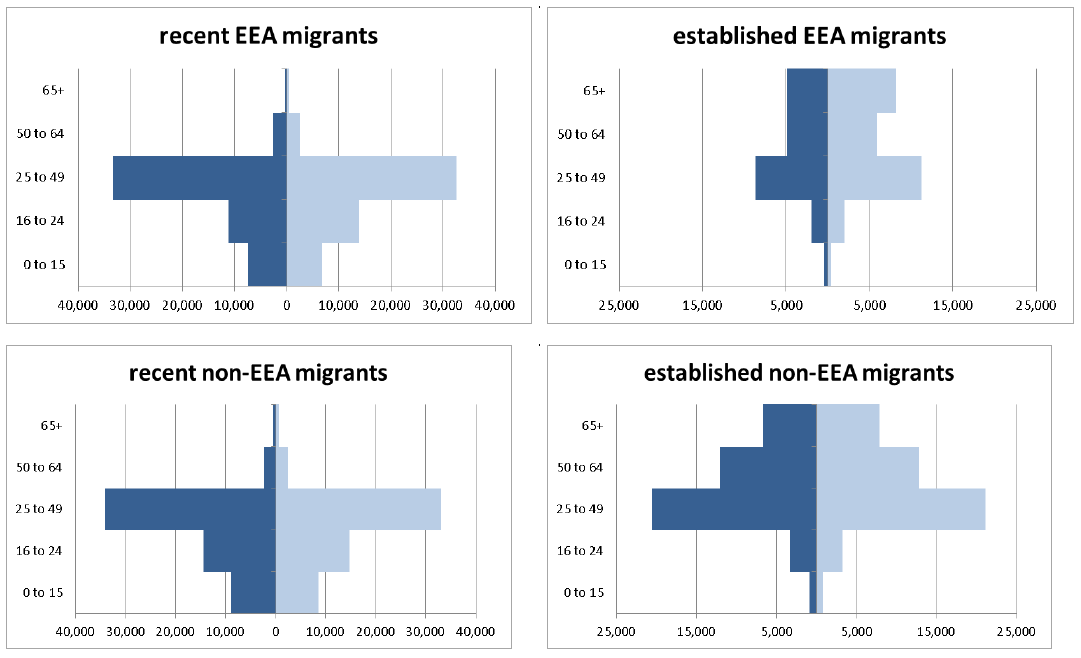
Source: 2011 Census, National Records of Scotland. Note there are no persons younger than 10 in the established migrant groups.
Chart 2.2. Age, Scotland population and all migrants
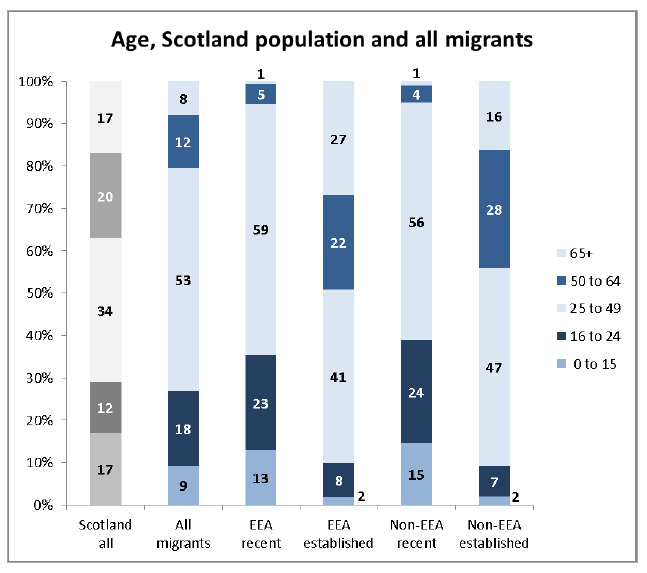
Source: 2011 Census, National Records of Scotland
Household composition
Across migrant groups couple families, without or without dependent children, were the most common household type, See Chart 2.3. Established migrants were more likely to live in 'one person' households than recent migrants, and recent EEA migrants were least likely to live in 'one person' households (9 per cent).
Recent migrants were most likely to live in a couple family household with dependent children (31 per cent of recent EEA and 38 per cent of recent non-EEA migrants).
'Other' households were relatively more common amongst recent migrants, which may be due to the larger proportion of students in the recent migrant groups.
Chart 2.3. Household composition, all migrants in households
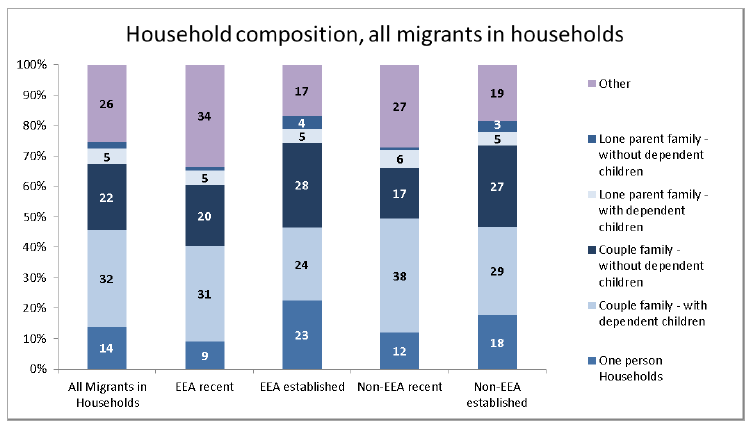
Source: 2011 Census, National Records of Scotland
Ethnicity
Amongst recent EEA migrants, the majority (87 per cent) reported their ethnicity as 'Other White' (including 'White Polish'). The proportion of EEA migrants who identified as 'White Irish' was much higher amongst established EEA migrants, with 25 per cent who reported a 'White Irish' ethnicity, compared to 7 per cent of recent EEA migrants. See Chart 2.4, and Annex Table A2.
As shown in Chart 2.5 (for detail see Annex Table A2), the non-EEA migrant groups were more ethnically diverse. Compared to established non-EEA migrants, recent non-EEA migrants were proportionally more likely to report 'African', 'Indian', 'Chinese' and 'other Asian' ethnicities.
Chart 2.4. Ethnicity, all EEA migrants
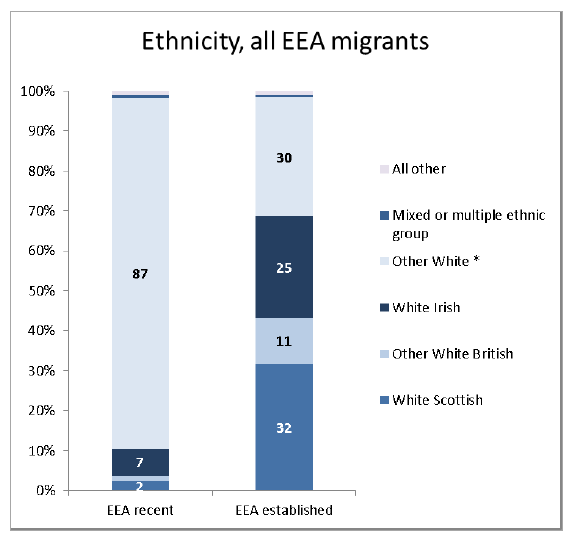
Source: 2011 Census, National Records of Scotland. Note: * Other White includes 'White Polish'.
Around a third of both established EEA and established non-EEA migrants reported their ethnicity as 'White Scottish' (32 and 31 per cent respectively).
Chart 2.5. Ethnicity, all non-EEA migrants
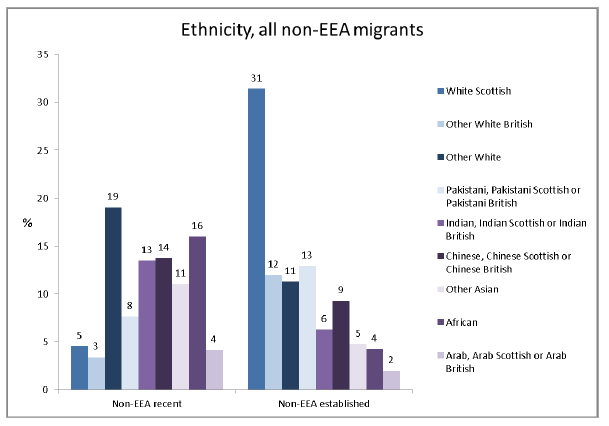
Source: 2011 Census, National Records of Scotland. Note: not all ethnicities shown, see Annex Table A2.
Religion
Charts 2.6 and 2.7 show that EEA and non-EEA migrants differed in their religious beliefs.
The most common religion reported by EEA migrants (54 per cent of recent, and 38 per cent of established migrants) was Roman Catholic. Around one in five of non-EEA migrants were Muslim, 3 to 9 per cent Hindu, and a further 11 to 17 per cent reported 'other Christian' as their religion.
One in seven established migrants (12 per cent EEA and 15 per cent non-EEA) reported their religion as 'Church of Scotland', and a quarter of those who arrived recently, irrespective of whether from EEA or non-EEA countries, reported that they had 'no religion'.
Chart 2.6. Religion, all EEA migrants.
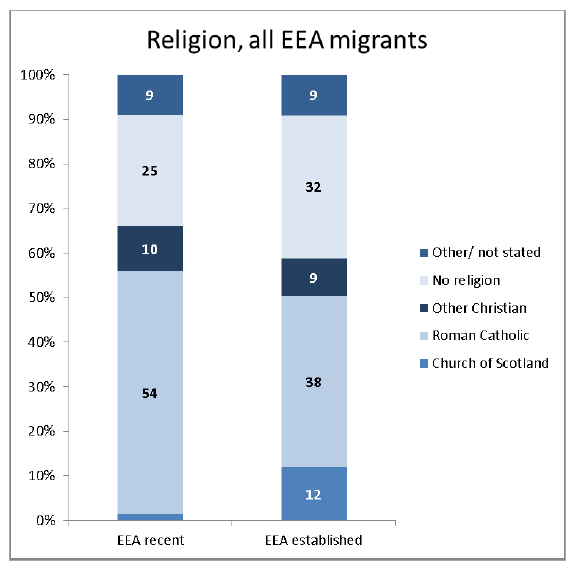
Source: 2011 Census, National Records of Scotland
Chart 2.7. Religion, all non-EEA migrants.
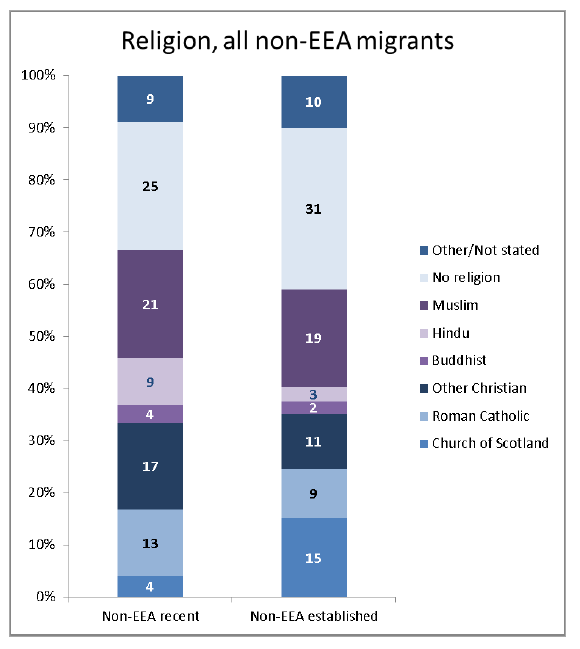
Source: 2011 Census, National Records of Scotland
National identity
Around a quarter of established EEA and established non-EEA migrants reported 'Scottish only' national identity (25 and 26 per cent respectively). A further 16 per cent of established EEA migrants reported 'British only' national identity, compared to 31 per cent of established non-EEA migrants. Conversely, 'other Identity only' national identity was most common amongst recent arrivals from EEA and non-EEA countries (84 and 71 per cent respectively). See Chart 2.8 (for detail see Annex Table A3).
Chart 2.8. Scottish, British and 'Other' National identity, all migrants.
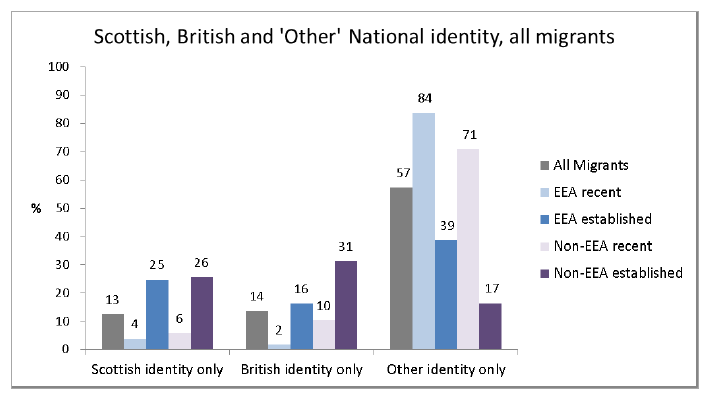
Source: 2011 Census, National Records of Scotland;
Other national identity categories not shown. For full detail see Table A3 in annex.
Language
89 per cent of migrants aged 3 and above reported that they could 'speak, read and write in English', and 2 per cent reported having 'no skills in English'. This compares to 94 per cent and 0.17 per cent of the Scottish population as a whole[5].
English skills were lowest amongst recent EEA migrants, of whom 81 per cent could 'speak, read and write in English', and a further 9 per cent had 'spoken English only'.
Chart 2.9. English language skills, all migrants aged 3 years and above.
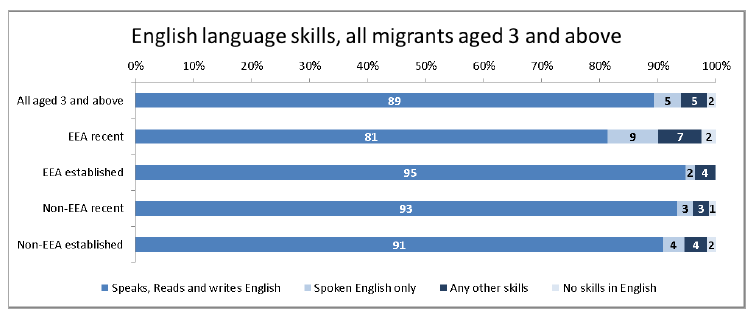
Source: 2011 Census, National Records of Scotland
Chart 2.10 shows that migrants who arrived at younger ages were more likely to have English language skills than those who arrived at older ages, especially those who arrived aged 50 or above. The latter only represent a small proportion of all migrants (see Chart 1.4).
Chart 2.10. English language skills and age at arrival in the UK, all migrants aged 3 years and above.
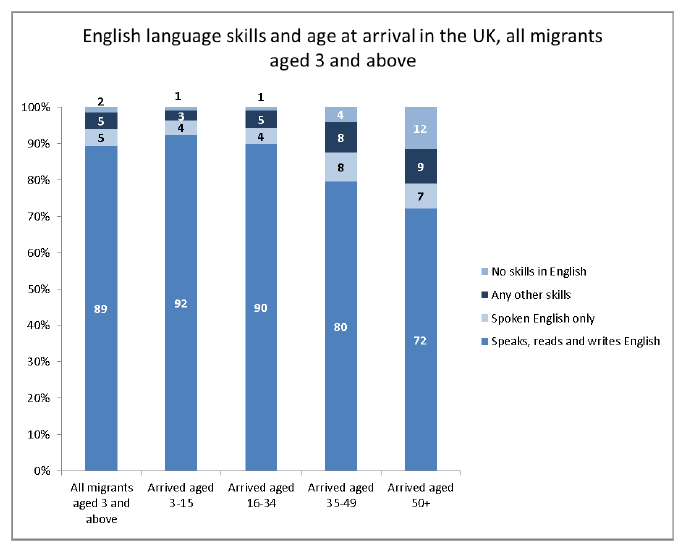
Source: 2011 Census, National Records of Scotland
This pattern of language skills and age at arrival was similar across migrant groups, with the exception of established EEA migrants, where 'no skills in English' was uncommon across all age groups. See Chart 2.11.
Chart 2.11. No skills in English and age at arrival, all migrants aged 3 and above.
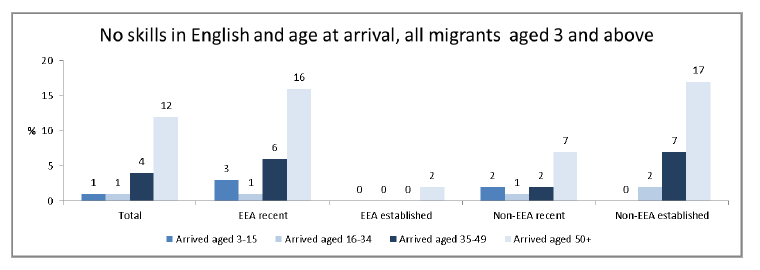
Source: 2011 Census, National Records of Scotland
Languages used in the home
More than 170 languages other than English are spoken in homes across Scotland[6].
Two in five (42 per cent) of all migrants spoke only English at home. This varied from 19 per cent of recent EEA migrants to 77 per cent of established EEA migrants. Less than 1 per cent of migrants aged 3 and above spoke Scots or Gaelic at home. Of the other eight most common languages spoken in Scottish homes, Polish was spoken by 46 per cent of recent EEA migrants, and Chinese was spoken by 13 per cent of recent non-EEA and 8 per cent of established non-EEA migrants. Punjabi was more commonly spoken amongst established non-EEA migrants (8 per cent) than recent non-EEA migrants (2 per cent). See chart 2.12.
Chart 2.12. Languages spoken at home, all migrants aged 3 and above.
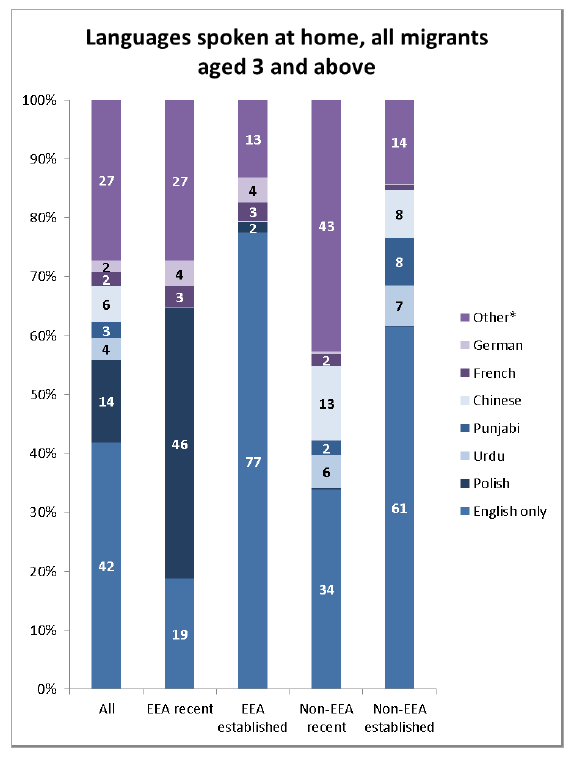
Source: 2011 Census, National Records of Scotland; Note: * other includes Scots and Gaelic.
Contact
Email: Wendy van Rijswijk
There is a problem
Thanks for your feedback